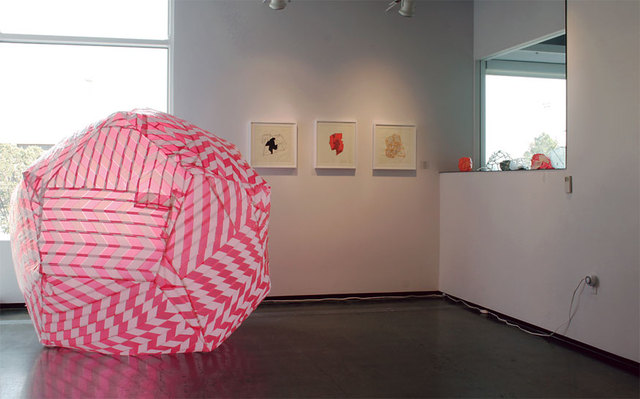With the 50 th anniversary of Tamarind Institute still glimmering in the rearview mirror, I sat down to talk with gallery director Arif Khan about fast forward: four for the future , which features pieces by Anna Hepler, Fay Ku, Mark Licari and Ethan Murrow. The show is a mix of work made by these artists during their time at Tamarind and in their own studio practices, ranging from high-definition film to inflatable sculptures, wall drawings and watercolors. Talk about how this show came together, about the artists and their relationship to Tamarind. Well, this is our second exhibition in the new building, the first one being part of the 50 th anniversary celebration. We had been looking at the past, at our history—because of the anniversary—and thought, Let’s look ahead. We have been working with some of these younger artists for the past few years, and we thought this would be a good way to show that what we do at Tamarind is contemporary and relevant, that we’re not just focused on our history. We had talked, before we moved into the new building, that having a proper exhibition space could allow us to put the work we do in lithography in the context of what artists do in their other studio practices. For example, if we knew an artist was coming in advance, we could plan an exhibit that would showcase their paintings or sculptures. That’s what’s happening in this show: You have prints these artists made at Tamarind as well as examples of work they usually make in their studios. Yeah, correct. So knowing that, then I wanted to have a mix of types of work. So, with Anna Hepler we have plastic sculpture objects—the Inflatable series. With Ethan Murrow, he does graphite drawings, which is why we were attracted to him for doing prints. But the basis for those drawings is the video and film work that he does. Then Fay Ku, who does—I hate to say traditional—but watercolor and graphite work, so you get a mix of things. The idea with Mark [Licari] ,
was that we knew he had done wall drawings in the past, along with working in prints and large-scale drawing on paper. We called him up and he seemed excited to come to the space and do it. We thought it would be a cool thing to do as part of the exhibition. What do you think these four artists get out of being part of this show—in the context of showing both ways of working ?Some of it was the hope of what the audience would get out of it: not having the pieces appear to be separate endeavors. Simply by having them in the same physical proximity we see the relationships between the work. I think, especially with print workshops, such as Tamarind, there’s a tendency to just focus on the technical and the process aspect of things, but for the artist, while that’s important, I think there are aesthetic reasons why they want to work in prints. I think you can see that more obviously by having the work close together. The best example in this show would be Anna Hepler’s sculptures. When she was describing how they operate for her, she said that the reason they’re inflatable is that there is no proper state they’re supposed to be in, so at all stages of their inflating and deflating they are still considered a piece. The collapsing of form in her Inflatable series is mirrored in her prints, where this is explored in two dimensions. As an artist who works in three dimensions, she feels that printmaking is the best two-dimensional medium to work in because of the physical processes involved. Have you seen the audience change since your move? Doing a comparison between the old building and the new space … that gallery was considered more of a show room. It was mostly highlighting recent prints that we had finished. It was very small. With a few exceptions, it’s hard to say we were doing proper exhibitions. So here, the idea is to over time build an exhibition schedule that people will start associating with Tamarind—not just with producing prints and its educational activities—but also as a place to see thoughtfully curated exhibitions that relate to the work that Tamarind does. I think that opening with this type of show, the idea was to, right out of the gate, expand what people expect to see here.
fast forward: four for the future
Runs through March 4, weekdays 9 a.m. to 5 p.m.Tamarind Institute2500 Central SEtamarind.unm.edu











